2806 NRS Assessment 3: Critical Evaluation of a Research Study
VerifiedAdded on 2023/03/17
|12
|3073
|27
Report
AI Summary
This report presents a critical evaluation of a randomized controlled trial (RCT) investigating the effectiveness of skin glue in reducing the failure rate of peripheral intravenous catheters (PICs) in emergency department patients. The study, published in the 'Annals of Emergency Medicine,' compared standard PIC care with the addition of skin glue. The report analyzes the study's introduction, title, abstract, research design, sample, data collection, analysis, and results. The findings indicated a lower failure rate in the intervention group, where skin glue was applied. The report discusses the relevance of the study to clinical nursing practice, emphasizing its implications for evidence-based practice and patient care. The evaluation also highlights the study's strengths, limitations, and potential for practice changes, emphasizing the importance of incorporating research findings into clinical decision-making to improve patient outcomes and reduce complications associated with PICs. The study's relevance to nursing students and newly placed nurses are also discussed.
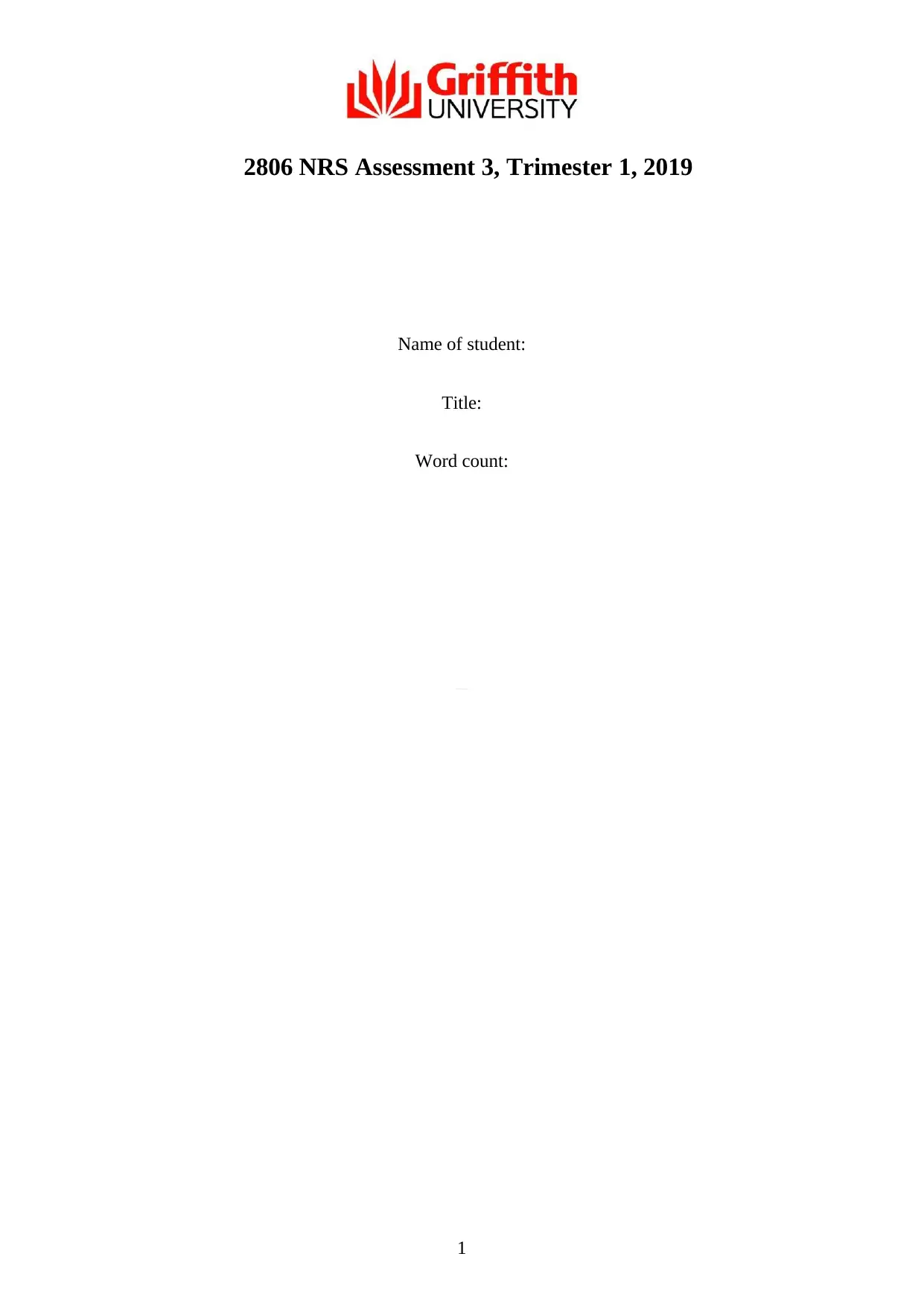
SONM Use Only
2806 NRS Assessment 3, Trimester 1, 2019
Name of student:
Title:
Word count:
1
2806 NRS Assessment 3, Trimester 1, 2019
Name of student:
Title:
Word count:
1
Paraphrase This Document
Need a fresh take? Get an instant paraphrase of this document with our AI Paraphraser
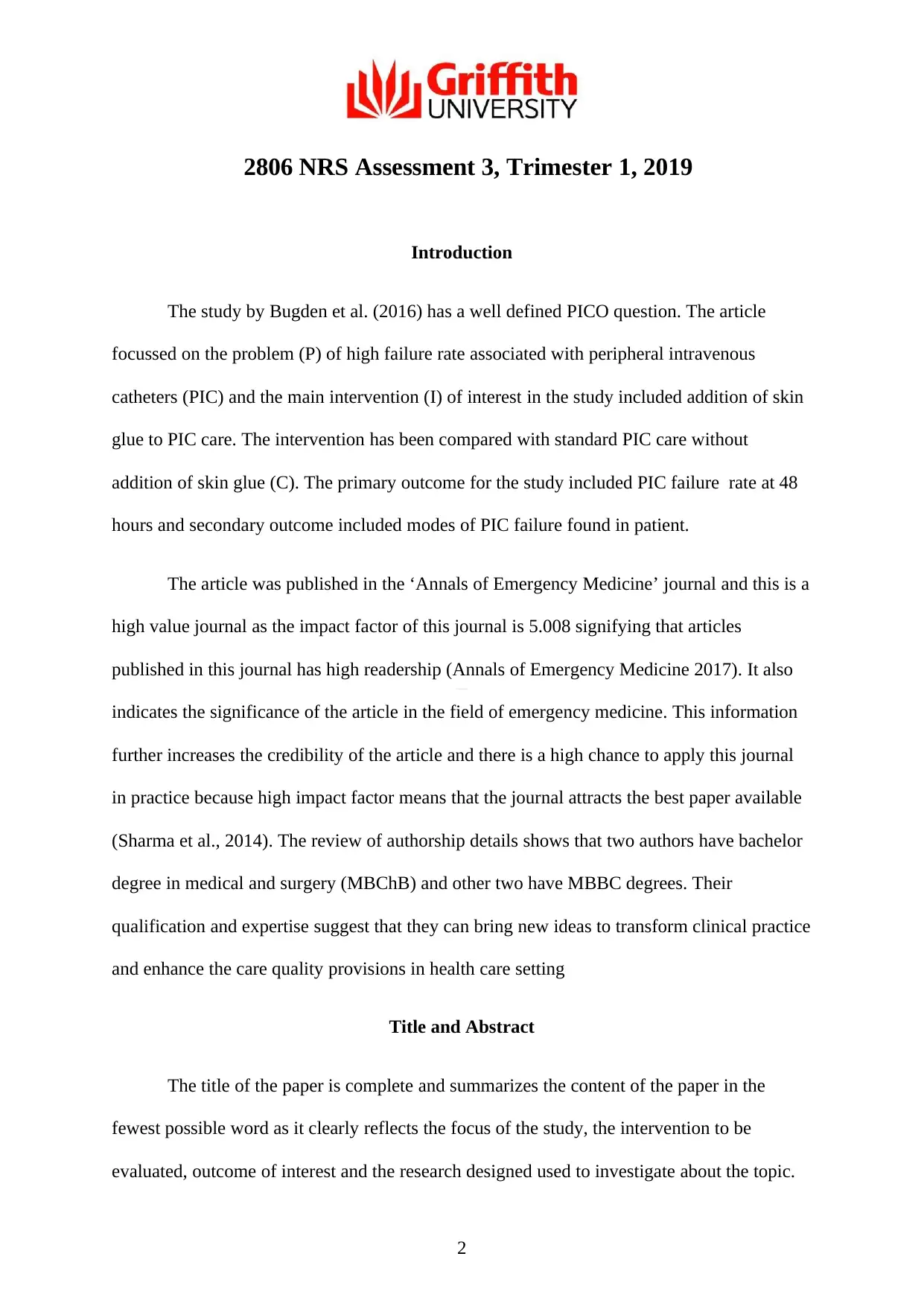
SONM Use Only
2806 NRS Assessment 3, Trimester 1, 2019
Introduction
The study by Bugden et al. (2016) has a well defined PICO question. The article
focussed on the problem (P) of high failure rate associated with peripheral intravenous
catheters (PIC) and the main intervention (I) of interest in the study included addition of skin
glue to PIC care. The intervention has been compared with standard PIC care without
addition of skin glue (C). The primary outcome for the study included PIC failure rate at 48
hours and secondary outcome included modes of PIC failure found in patient.
The article was published in the ‘Annals of Emergency Medicine’ journal and this is a
high value journal as the impact factor of this journal is 5.008 signifying that articles
published in this journal has high readership (Annals of Emergency Medicine 2017). It also
indicates the significance of the article in the field of emergency medicine. This information
further increases the credibility of the article and there is a high chance to apply this journal
in practice because high impact factor means that the journal attracts the best paper available
(Sharma et al., 2014). The review of authorship details shows that two authors have bachelor
degree in medical and surgery (MBChB) and other two have MBBC degrees. Their
qualification and expertise suggest that they can bring new ideas to transform clinical practice
and enhance the care quality provisions in health care setting
Title and Abstract
The title of the paper is complete and summarizes the content of the paper in the
fewest possible word as it clearly reflects the focus of the study, the intervention to be
evaluated, outcome of interest and the research designed used to investigate about the topic.
2
2806 NRS Assessment 3, Trimester 1, 2019
Introduction
The study by Bugden et al. (2016) has a well defined PICO question. The article
focussed on the problem (P) of high failure rate associated with peripheral intravenous
catheters (PIC) and the main intervention (I) of interest in the study included addition of skin
glue to PIC care. The intervention has been compared with standard PIC care without
addition of skin glue (C). The primary outcome for the study included PIC failure rate at 48
hours and secondary outcome included modes of PIC failure found in patient.
The article was published in the ‘Annals of Emergency Medicine’ journal and this is a
high value journal as the impact factor of this journal is 5.008 signifying that articles
published in this journal has high readership (Annals of Emergency Medicine 2017). It also
indicates the significance of the article in the field of emergency medicine. This information
further increases the credibility of the article and there is a high chance to apply this journal
in practice because high impact factor means that the journal attracts the best paper available
(Sharma et al., 2014). The review of authorship details shows that two authors have bachelor
degree in medical and surgery (MBChB) and other two have MBBC degrees. Their
qualification and expertise suggest that they can bring new ideas to transform clinical practice
and enhance the care quality provisions in health care setting
Title and Abstract
The title of the paper is complete and summarizes the content of the paper in the
fewest possible word as it clearly reflects the focus of the study, the intervention to be
evaluated, outcome of interest and the research designed used to investigate about the topic.
2
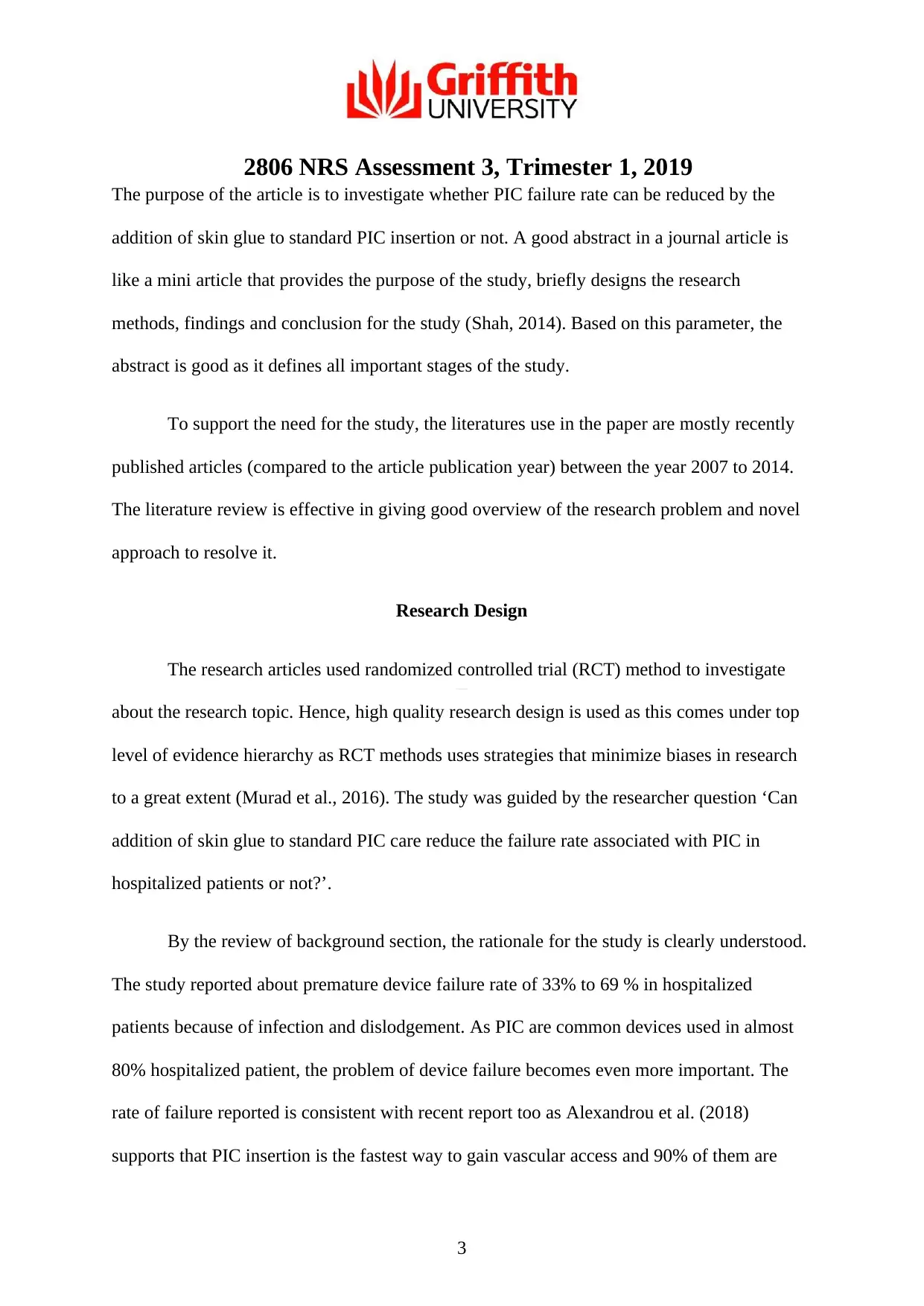
SONM Use Only
2806 NRS Assessment 3, Trimester 1, 2019
The purpose of the article is to investigate whether PIC failure rate can be reduced by the
addition of skin glue to standard PIC insertion or not. A good abstract in a journal article is
like a mini article that provides the purpose of the study, briefly designs the research
methods, findings and conclusion for the study (Shah, 2014). Based on this parameter, the
abstract is good as it defines all important stages of the study.
To support the need for the study, the literatures use in the paper are mostly recently
published articles (compared to the article publication year) between the year 2007 to 2014.
The literature review is effective in giving good overview of the research problem and novel
approach to resolve it.
Research Design
The research articles used randomized controlled trial (RCT) method to investigate
about the research topic. Hence, high quality research design is used as this comes under top
level of evidence hierarchy as RCT methods uses strategies that minimize biases in research
to a great extent (Murad et al., 2016). The study was guided by the researcher question ‘Can
addition of skin glue to standard PIC care reduce the failure rate associated with PIC in
hospitalized patients or not?’.
By the review of background section, the rationale for the study is clearly understood.
The study reported about premature device failure rate of 33% to 69 % in hospitalized
patients because of infection and dislodgement. As PIC are common devices used in almost
80% hospitalized patient, the problem of device failure becomes even more important. The
rate of failure reported is consistent with recent report too as Alexandrou et al. (2018)
supports that PIC insertion is the fastest way to gain vascular access and 90% of them are
3
2806 NRS Assessment 3, Trimester 1, 2019
The purpose of the article is to investigate whether PIC failure rate can be reduced by the
addition of skin glue to standard PIC insertion or not. A good abstract in a journal article is
like a mini article that provides the purpose of the study, briefly designs the research
methods, findings and conclusion for the study (Shah, 2014). Based on this parameter, the
abstract is good as it defines all important stages of the study.
To support the need for the study, the literatures use in the paper are mostly recently
published articles (compared to the article publication year) between the year 2007 to 2014.
The literature review is effective in giving good overview of the research problem and novel
approach to resolve it.
Research Design
The research articles used randomized controlled trial (RCT) method to investigate
about the research topic. Hence, high quality research design is used as this comes under top
level of evidence hierarchy as RCT methods uses strategies that minimize biases in research
to a great extent (Murad et al., 2016). The study was guided by the researcher question ‘Can
addition of skin glue to standard PIC care reduce the failure rate associated with PIC in
hospitalized patients or not?’.
By the review of background section, the rationale for the study is clearly understood.
The study reported about premature device failure rate of 33% to 69 % in hospitalized
patients because of infection and dislodgement. As PIC are common devices used in almost
80% hospitalized patient, the problem of device failure becomes even more important. The
rate of failure reported is consistent with recent report too as Alexandrou et al. (2018)
supports that PIC insertion is the fastest way to gain vascular access and 90% of them are
3
⊘ This is a preview!⊘
Do you want full access?
Subscribe today to unlock all pages.

Trusted by 1+ million students worldwide
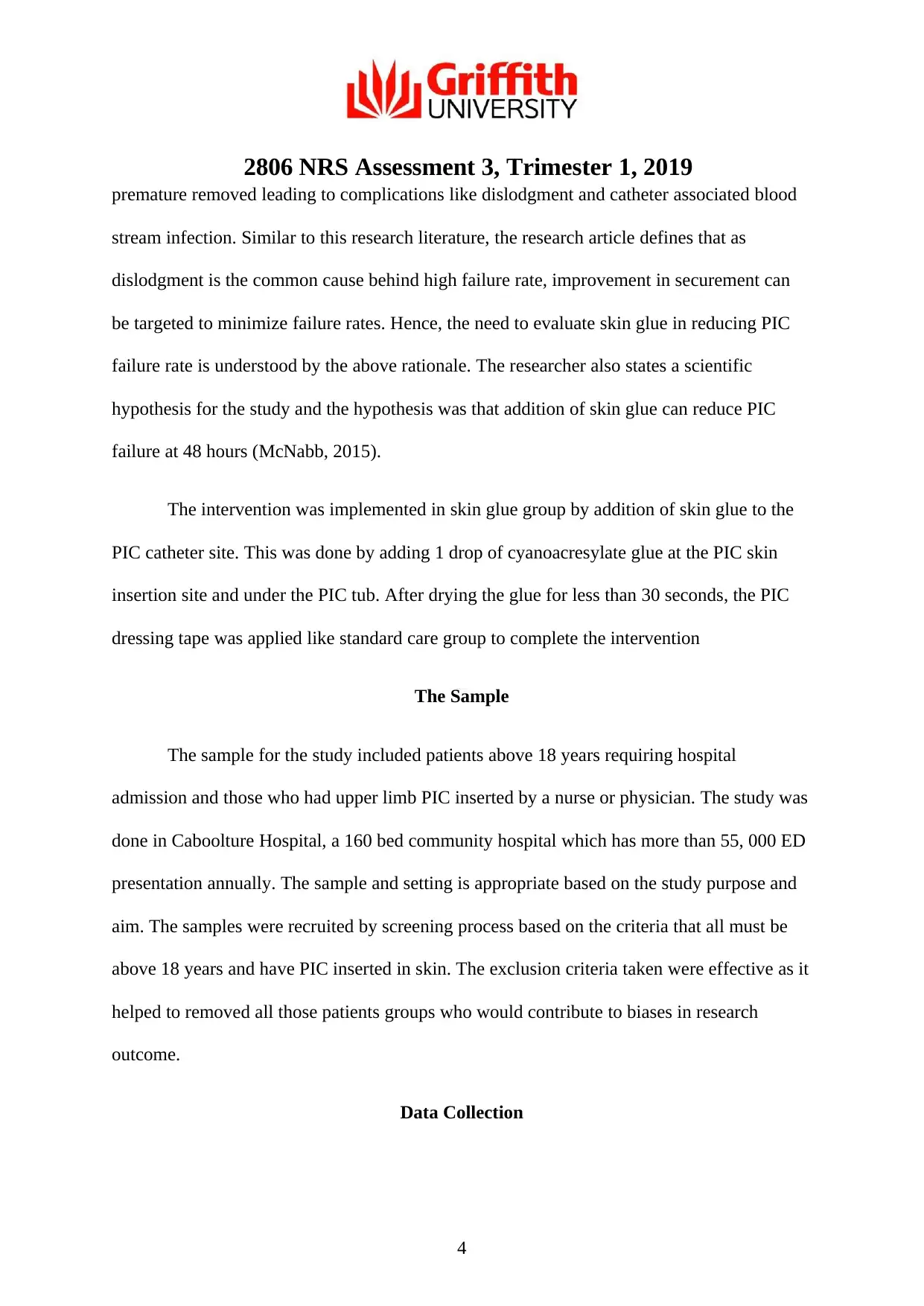
SONM Use Only
2806 NRS Assessment 3, Trimester 1, 2019
premature removed leading to complications like dislodgment and catheter associated blood
stream infection. Similar to this research literature, the research article defines that as
dislodgment is the common cause behind high failure rate, improvement in securement can
be targeted to minimize failure rates. Hence, the need to evaluate skin glue in reducing PIC
failure rate is understood by the above rationale. The researcher also states a scientific
hypothesis for the study and the hypothesis was that addition of skin glue can reduce PIC
failure at 48 hours (McNabb, 2015).
The intervention was implemented in skin glue group by addition of skin glue to the
PIC catheter site. This was done by adding 1 drop of cyanoacresylate glue at the PIC skin
insertion site and under the PIC tub. After drying the glue for less than 30 seconds, the PIC
dressing tape was applied like standard care group to complete the intervention
The Sample
The sample for the study included patients above 18 years requiring hospital
admission and those who had upper limb PIC inserted by a nurse or physician. The study was
done in Caboolture Hospital, a 160 bed community hospital which has more than 55, 000 ED
presentation annually. The sample and setting is appropriate based on the study purpose and
aim. The samples were recruited by screening process based on the criteria that all must be
above 18 years and have PIC inserted in skin. The exclusion criteria taken were effective as it
helped to removed all those patients groups who would contribute to biases in research
outcome.
Data Collection
4
2806 NRS Assessment 3, Trimester 1, 2019
premature removed leading to complications like dislodgment and catheter associated blood
stream infection. Similar to this research literature, the research article defines that as
dislodgment is the common cause behind high failure rate, improvement in securement can
be targeted to minimize failure rates. Hence, the need to evaluate skin glue in reducing PIC
failure rate is understood by the above rationale. The researcher also states a scientific
hypothesis for the study and the hypothesis was that addition of skin glue can reduce PIC
failure at 48 hours (McNabb, 2015).
The intervention was implemented in skin glue group by addition of skin glue to the
PIC catheter site. This was done by adding 1 drop of cyanoacresylate glue at the PIC skin
insertion site and under the PIC tub. After drying the glue for less than 30 seconds, the PIC
dressing tape was applied like standard care group to complete the intervention
The Sample
The sample for the study included patients above 18 years requiring hospital
admission and those who had upper limb PIC inserted by a nurse or physician. The study was
done in Caboolture Hospital, a 160 bed community hospital which has more than 55, 000 ED
presentation annually. The sample and setting is appropriate based on the study purpose and
aim. The samples were recruited by screening process based on the criteria that all must be
above 18 years and have PIC inserted in skin. The exclusion criteria taken were effective as it
helped to removed all those patients groups who would contribute to biases in research
outcome.
Data Collection
4
Paraphrase This Document
Need a fresh take? Get an instant paraphrase of this document with our AI Paraphraser
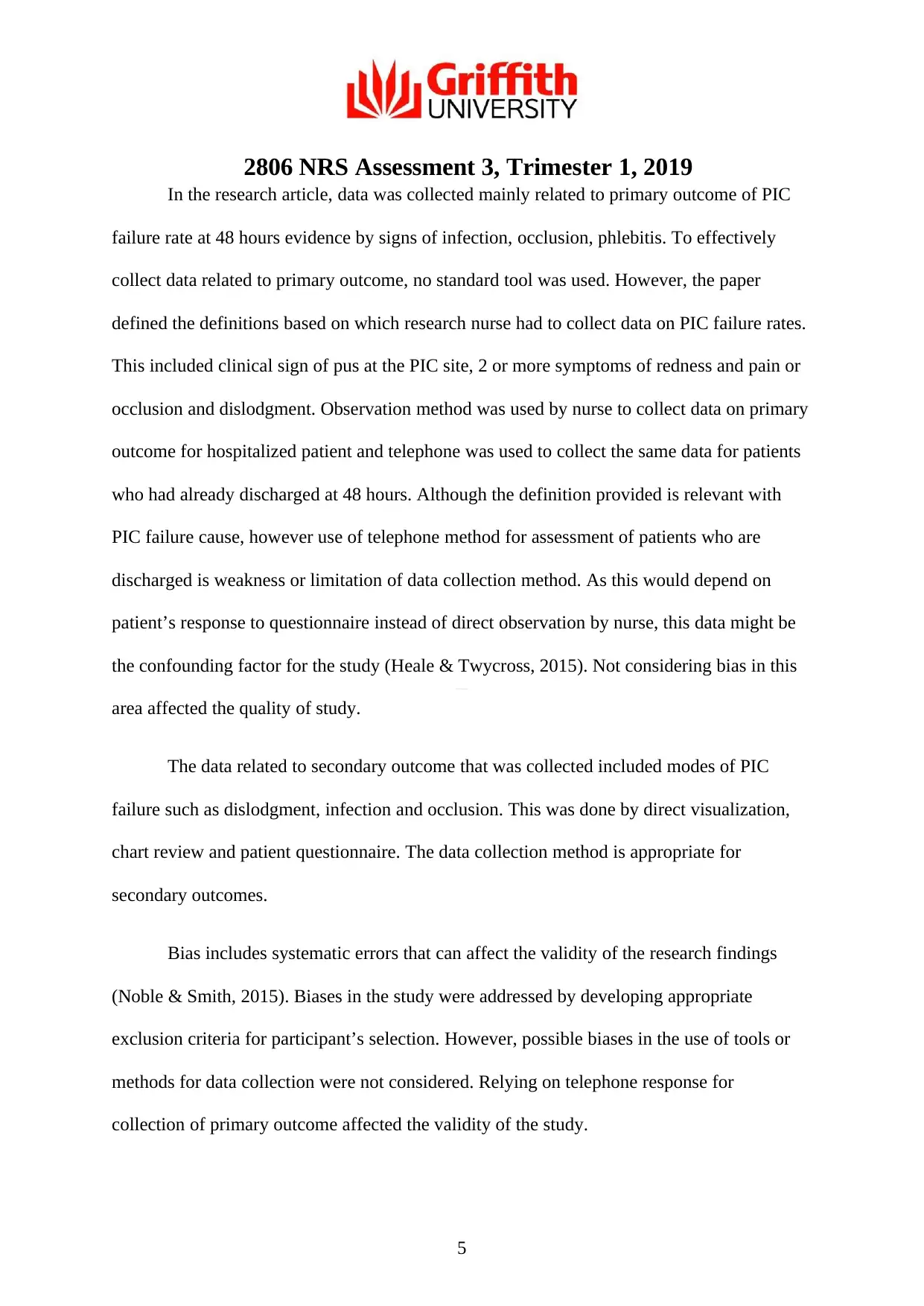
SONM Use Only
2806 NRS Assessment 3, Trimester 1, 2019
In the research article, data was collected mainly related to primary outcome of PIC
failure rate at 48 hours evidence by signs of infection, occlusion, phlebitis. To effectively
collect data related to primary outcome, no standard tool was used. However, the paper
defined the definitions based on which research nurse had to collect data on PIC failure rates.
This included clinical sign of pus at the PIC site, 2 or more symptoms of redness and pain or
occlusion and dislodgment. Observation method was used by nurse to collect data on primary
outcome for hospitalized patient and telephone was used to collect the same data for patients
who had already discharged at 48 hours. Although the definition provided is relevant with
PIC failure cause, however use of telephone method for assessment of patients who are
discharged is weakness or limitation of data collection method. As this would depend on
patient’s response to questionnaire instead of direct observation by nurse, this data might be
the confounding factor for the study (Heale & Twycross, 2015). Not considering bias in this
area affected the quality of study.
The data related to secondary outcome that was collected included modes of PIC
failure such as dislodgment, infection and occlusion. This was done by direct visualization,
chart review and patient questionnaire. The data collection method is appropriate for
secondary outcomes.
Bias includes systematic errors that can affect the validity of the research findings
(Noble & Smith, 2015). Biases in the study were addressed by developing appropriate
exclusion criteria for participant’s selection. However, possible biases in the use of tools or
methods for data collection were not considered. Relying on telephone response for
collection of primary outcome affected the validity of the study.
5
2806 NRS Assessment 3, Trimester 1, 2019
In the research article, data was collected mainly related to primary outcome of PIC
failure rate at 48 hours evidence by signs of infection, occlusion, phlebitis. To effectively
collect data related to primary outcome, no standard tool was used. However, the paper
defined the definitions based on which research nurse had to collect data on PIC failure rates.
This included clinical sign of pus at the PIC site, 2 or more symptoms of redness and pain or
occlusion and dislodgment. Observation method was used by nurse to collect data on primary
outcome for hospitalized patient and telephone was used to collect the same data for patients
who had already discharged at 48 hours. Although the definition provided is relevant with
PIC failure cause, however use of telephone method for assessment of patients who are
discharged is weakness or limitation of data collection method. As this would depend on
patient’s response to questionnaire instead of direct observation by nurse, this data might be
the confounding factor for the study (Heale & Twycross, 2015). Not considering bias in this
area affected the quality of study.
The data related to secondary outcome that was collected included modes of PIC
failure such as dislodgment, infection and occlusion. This was done by direct visualization,
chart review and patient questionnaire. The data collection method is appropriate for
secondary outcomes.
Bias includes systematic errors that can affect the validity of the research findings
(Noble & Smith, 2015). Biases in the study were addressed by developing appropriate
exclusion criteria for participant’s selection. However, possible biases in the use of tools or
methods for data collection were not considered. Relying on telephone response for
collection of primary outcome affected the validity of the study.
5

SONM Use Only
2806 NRS Assessment 3, Trimester 1, 2019
Data Analysis
The quantitative results for the study was evaluated by the use of statistical software
called Stata. All the data was exported into Stata version 12.1. In addition, the data analysis
focussed on evaluation absolute differences by calculating 95% confidence interval and
P< .05. The significance of using p value is that it can help to determine the statistical
significance of research outcome (Greenland et al., 2016).
Results
Based on the comparison of PIC failure rate in standard care group and intervention
group, the study revealed reduction in failure rate for intervention group (17%) compared to
control group. As the research question for the study aimed to evaluate whether skin glue
addition to standard PIC care can reduce device failure rate, this research outcome answers
the research question and shows that the skin glue intervention is effective in minimizing the
rate of premature device failure. Skin dislodgment is the main cause behind failure rate and
the results for secondary outcome revealed that rate of dislodgment was less frequent in
intervention group (7%) compared to standard care group.
An adequate research summary and discussion is one where limitations are identified,
research implications are discussed and suggestion for practice improvement is discussed
Creswell and Poth (2017) gave evidence for future research by identifying limitations in
research and suggesting need for cost-benefit analysis of the skin glue intervention. This was
necessary to understand the economical benefits of the intervention in hospital setting. The
research findings are generalizable as the author has compared outcome with previous result
6
2806 NRS Assessment 3, Trimester 1, 2019
Data Analysis
The quantitative results for the study was evaluated by the use of statistical software
called Stata. All the data was exported into Stata version 12.1. In addition, the data analysis
focussed on evaluation absolute differences by calculating 95% confidence interval and
P< .05. The significance of using p value is that it can help to determine the statistical
significance of research outcome (Greenland et al., 2016).
Results
Based on the comparison of PIC failure rate in standard care group and intervention
group, the study revealed reduction in failure rate for intervention group (17%) compared to
control group. As the research question for the study aimed to evaluate whether skin glue
addition to standard PIC care can reduce device failure rate, this research outcome answers
the research question and shows that the skin glue intervention is effective in minimizing the
rate of premature device failure. Skin dislodgment is the main cause behind failure rate and
the results for secondary outcome revealed that rate of dislodgment was less frequent in
intervention group (7%) compared to standard care group.
An adequate research summary and discussion is one where limitations are identified,
research implications are discussed and suggestion for practice improvement is discussed
Creswell and Poth (2017) gave evidence for future research by identifying limitations in
research and suggesting need for cost-benefit analysis of the skin glue intervention. This was
necessary to understand the economical benefits of the intervention in hospital setting. The
research findings are generalizable as the author has compared outcome with previous result
6
⊘ This is a preview!⊘
Do you want full access?
Subscribe today to unlock all pages.

Trusted by 1+ million students worldwide
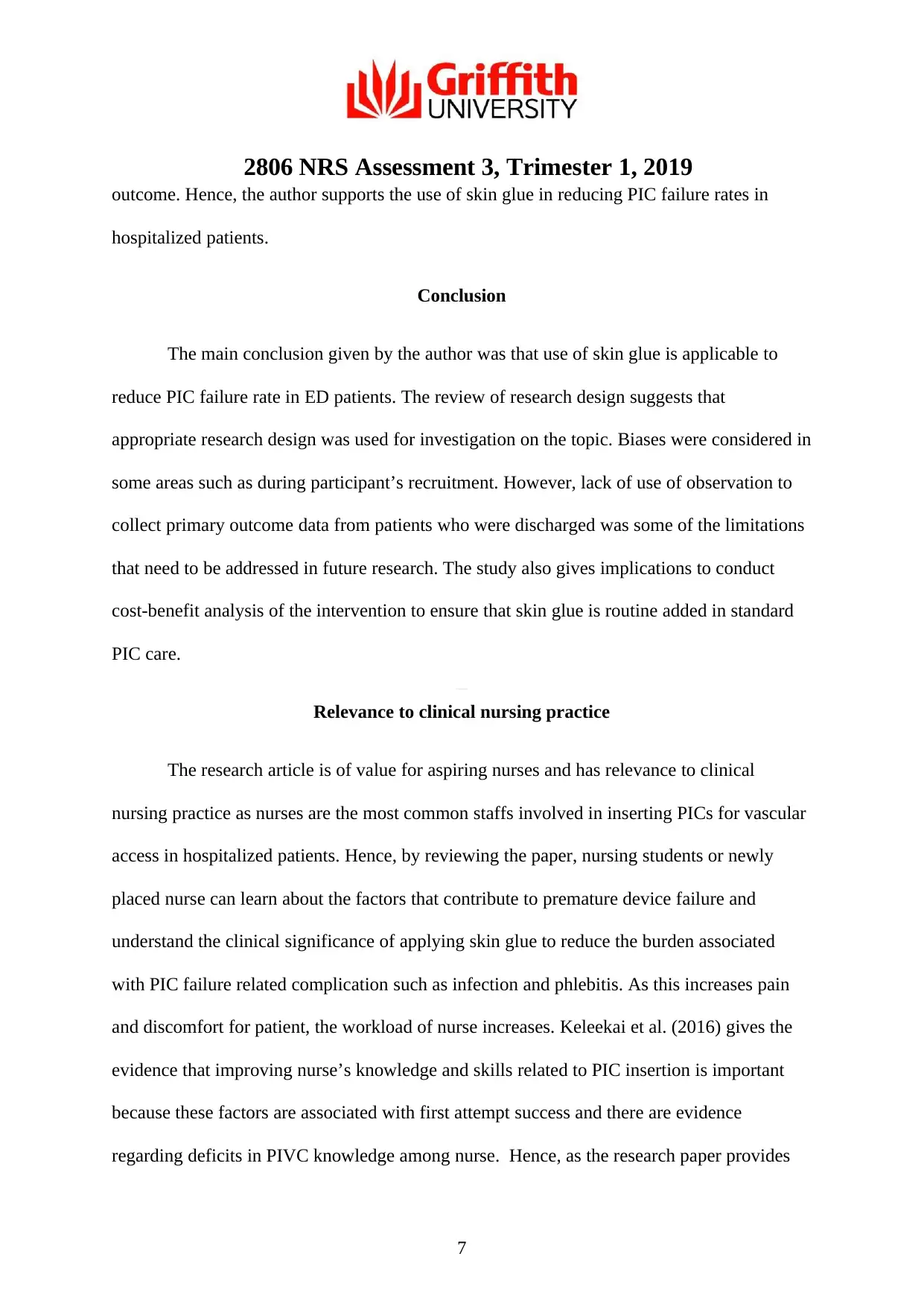
SONM Use Only
2806 NRS Assessment 3, Trimester 1, 2019
outcome. Hence, the author supports the use of skin glue in reducing PIC failure rates in
hospitalized patients.
Conclusion
The main conclusion given by the author was that use of skin glue is applicable to
reduce PIC failure rate in ED patients. The review of research design suggests that
appropriate research design was used for investigation on the topic. Biases were considered in
some areas such as during participant’s recruitment. However, lack of use of observation to
collect primary outcome data from patients who were discharged was some of the limitations
that need to be addressed in future research. The study also gives implications to conduct
cost-benefit analysis of the intervention to ensure that skin glue is routine added in standard
PIC care.
Relevance to clinical nursing practice
The research article is of value for aspiring nurses and has relevance to clinical
nursing practice as nurses are the most common staffs involved in inserting PICs for vascular
access in hospitalized patients. Hence, by reviewing the paper, nursing students or newly
placed nurse can learn about the factors that contribute to premature device failure and
understand the clinical significance of applying skin glue to reduce the burden associated
with PIC failure related complication such as infection and phlebitis. As this increases pain
and discomfort for patient, the workload of nurse increases. Keleekai et al. (2016) gives the
evidence that improving nurse’s knowledge and skills related to PIC insertion is important
because these factors are associated with first attempt success and there are evidence
regarding deficits in PIVC knowledge among nurse. Hence, as the research paper provides
7
2806 NRS Assessment 3, Trimester 1, 2019
outcome. Hence, the author supports the use of skin glue in reducing PIC failure rates in
hospitalized patients.
Conclusion
The main conclusion given by the author was that use of skin glue is applicable to
reduce PIC failure rate in ED patients. The review of research design suggests that
appropriate research design was used for investigation on the topic. Biases were considered in
some areas such as during participant’s recruitment. However, lack of use of observation to
collect primary outcome data from patients who were discharged was some of the limitations
that need to be addressed in future research. The study also gives implications to conduct
cost-benefit analysis of the intervention to ensure that skin glue is routine added in standard
PIC care.
Relevance to clinical nursing practice
The research article is of value for aspiring nurses and has relevance to clinical
nursing practice as nurses are the most common staffs involved in inserting PICs for vascular
access in hospitalized patients. Hence, by reviewing the paper, nursing students or newly
placed nurse can learn about the factors that contribute to premature device failure and
understand the clinical significance of applying skin glue to reduce the burden associated
with PIC failure related complication such as infection and phlebitis. As this increases pain
and discomfort for patient, the workload of nurse increases. Keleekai et al. (2016) gives the
evidence that improving nurse’s knowledge and skills related to PIC insertion is important
because these factors are associated with first attempt success and there are evidence
regarding deficits in PIVC knowledge among nurse. Hence, as the research paper provides
7
Paraphrase This Document
Need a fresh take? Get an instant paraphrase of this document with our AI Paraphraser
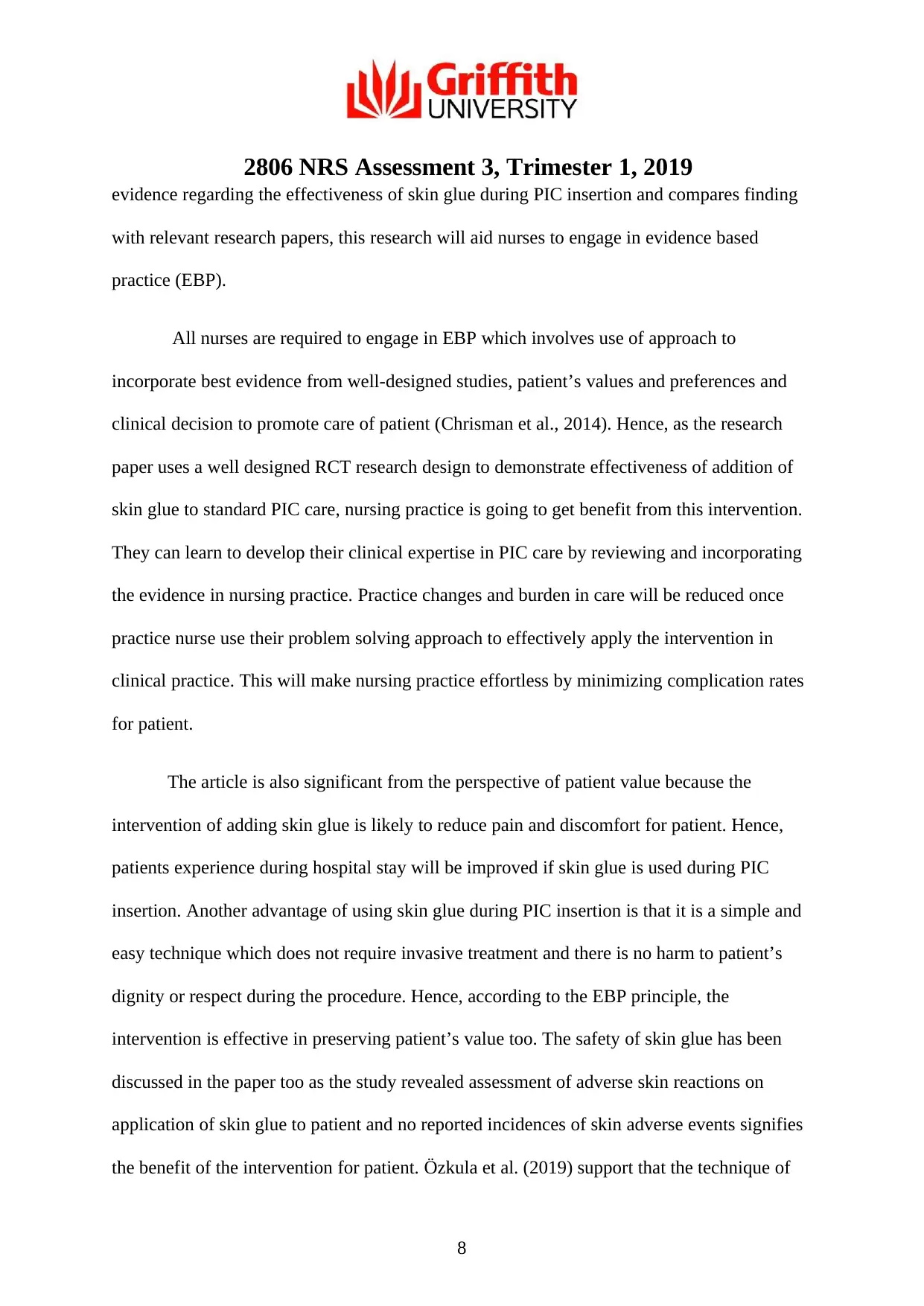
SONM Use Only
2806 NRS Assessment 3, Trimester 1, 2019
evidence regarding the effectiveness of skin glue during PIC insertion and compares finding
with relevant research papers, this research will aid nurses to engage in evidence based
practice (EBP).
All nurses are required to engage in EBP which involves use of approach to
incorporate best evidence from well-designed studies, patient’s values and preferences and
clinical decision to promote care of patient (Chrisman et al., 2014). Hence, as the research
paper uses a well designed RCT research design to demonstrate effectiveness of addition of
skin glue to standard PIC care, nursing practice is going to get benefit from this intervention.
They can learn to develop their clinical expertise in PIC care by reviewing and incorporating
the evidence in nursing practice. Practice changes and burden in care will be reduced once
practice nurse use their problem solving approach to effectively apply the intervention in
clinical practice. This will make nursing practice effortless by minimizing complication rates
for patient.
The article is also significant from the perspective of patient value because the
intervention of adding skin glue is likely to reduce pain and discomfort for patient. Hence,
patients experience during hospital stay will be improved if skin glue is used during PIC
insertion. Another advantage of using skin glue during PIC insertion is that it is a simple and
easy technique which does not require invasive treatment and there is no harm to patient’s
dignity or respect during the procedure. Hence, according to the EBP principle, the
intervention is effective in preserving patient’s value too. The safety of skin glue has been
discussed in the paper too as the study revealed assessment of adverse skin reactions on
application of skin glue to patient and no reported incidences of skin adverse events signifies
the benefit of the intervention for patient. Özkula et al. (2019) support that the technique of
8
2806 NRS Assessment 3, Trimester 1, 2019
evidence regarding the effectiveness of skin glue during PIC insertion and compares finding
with relevant research papers, this research will aid nurses to engage in evidence based
practice (EBP).
All nurses are required to engage in EBP which involves use of approach to
incorporate best evidence from well-designed studies, patient’s values and preferences and
clinical decision to promote care of patient (Chrisman et al., 2014). Hence, as the research
paper uses a well designed RCT research design to demonstrate effectiveness of addition of
skin glue to standard PIC care, nursing practice is going to get benefit from this intervention.
They can learn to develop their clinical expertise in PIC care by reviewing and incorporating
the evidence in nursing practice. Practice changes and burden in care will be reduced once
practice nurse use their problem solving approach to effectively apply the intervention in
clinical practice. This will make nursing practice effortless by minimizing complication rates
for patient.
The article is also significant from the perspective of patient value because the
intervention of adding skin glue is likely to reduce pain and discomfort for patient. Hence,
patients experience during hospital stay will be improved if skin glue is used during PIC
insertion. Another advantage of using skin glue during PIC insertion is that it is a simple and
easy technique which does not require invasive treatment and there is no harm to patient’s
dignity or respect during the procedure. Hence, according to the EBP principle, the
intervention is effective in preserving patient’s value too. The safety of skin glue has been
discussed in the paper too as the study revealed assessment of adverse skin reactions on
application of skin glue to patient and no reported incidences of skin adverse events signifies
the benefit of the intervention for patient. Özkula et al. (2019) support that the technique of
8
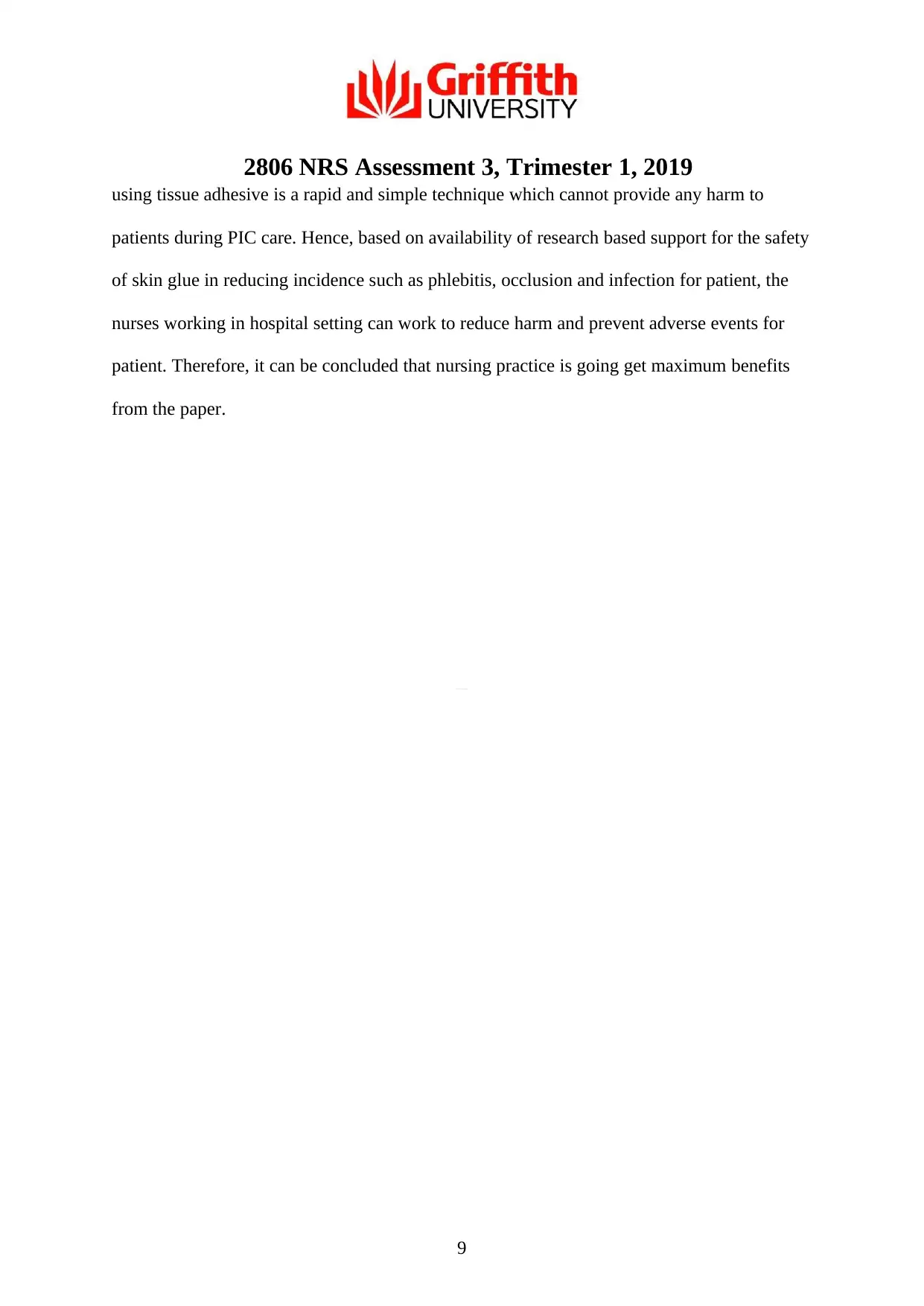
SONM Use Only
2806 NRS Assessment 3, Trimester 1, 2019
using tissue adhesive is a rapid and simple technique which cannot provide any harm to
patients during PIC care. Hence, based on availability of research based support for the safety
of skin glue in reducing incidence such as phlebitis, occlusion and infection for patient, the
nurses working in hospital setting can work to reduce harm and prevent adverse events for
patient. Therefore, it can be concluded that nursing practice is going get maximum benefits
from the paper.
9
2806 NRS Assessment 3, Trimester 1, 2019
using tissue adhesive is a rapid and simple technique which cannot provide any harm to
patients during PIC care. Hence, based on availability of research based support for the safety
of skin glue in reducing incidence such as phlebitis, occlusion and infection for patient, the
nurses working in hospital setting can work to reduce harm and prevent adverse events for
patient. Therefore, it can be concluded that nursing practice is going get maximum benefits
from the paper.
9
⊘ This is a preview!⊘
Do you want full access?
Subscribe today to unlock all pages.

Trusted by 1+ million students worldwide
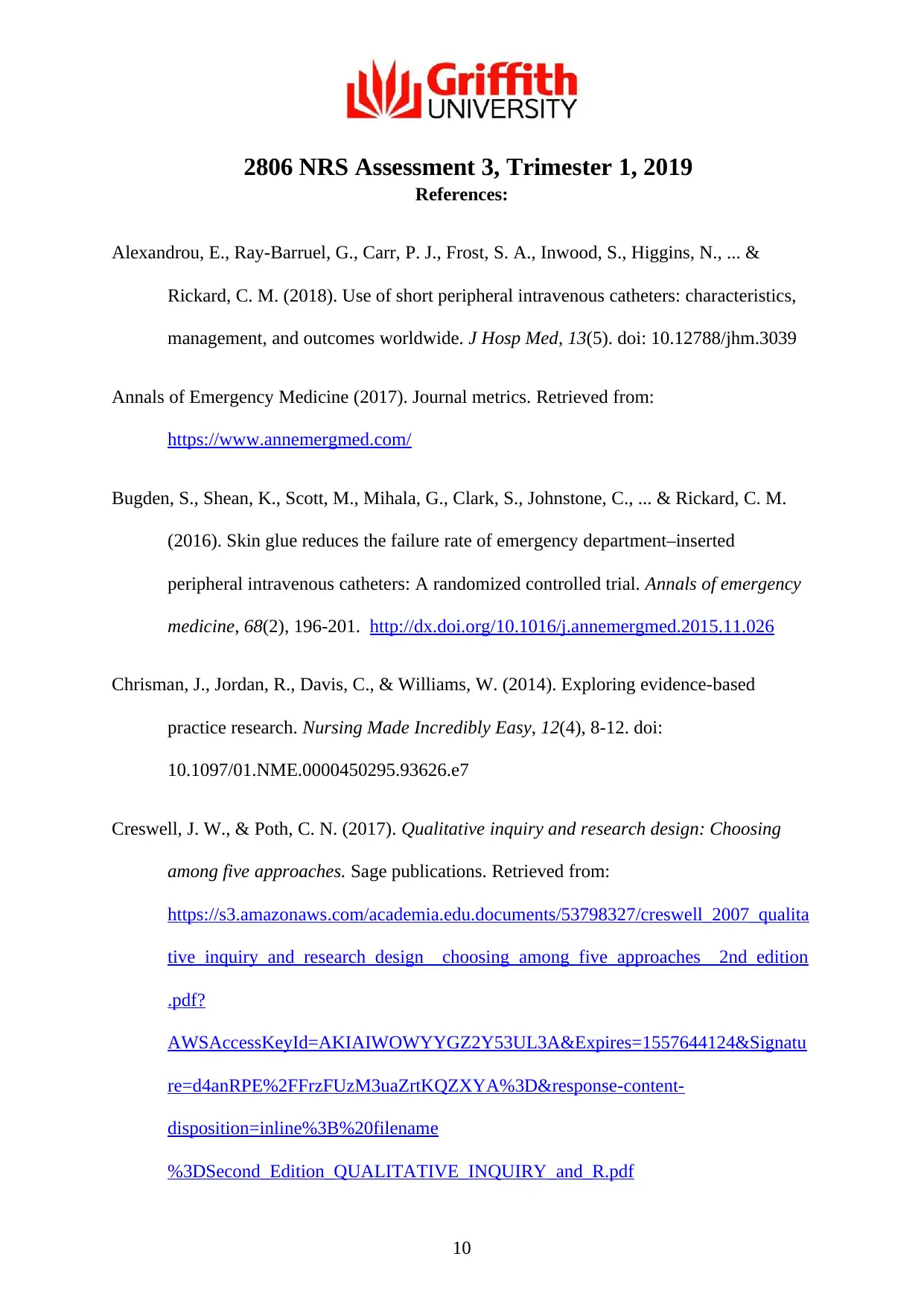
SONM Use Only
2806 NRS Assessment 3, Trimester 1, 2019
References:
Alexandrou, E., Ray-Barruel, G., Carr, P. J., Frost, S. A., Inwood, S., Higgins, N., ... &
Rickard, C. M. (2018). Use of short peripheral intravenous catheters: characteristics,
management, and outcomes worldwide. J Hosp Med, 13(5). doi: 10.12788/jhm.3039
Annals of Emergency Medicine (2017). Journal metrics. Retrieved from:
https://www.annemergmed.com/
Bugden, S., Shean, K., Scott, M., Mihala, G., Clark, S., Johnstone, C., ... & Rickard, C. M.
(2016). Skin glue reduces the failure rate of emergency department–inserted
peripheral intravenous catheters: A randomized controlled trial. Annals of emergency
medicine, 68(2), 196-201. http://dx.doi.org/10.1016/j.annemergmed.2015.11.026
Chrisman, J., Jordan, R., Davis, C., & Williams, W. (2014). Exploring evidence-based
practice research. Nursing Made Incredibly Easy, 12(4), 8-12. doi:
10.1097/01.NME.0000450295.93626.e7
Creswell, J. W., & Poth, C. N. (2017). Qualitative inquiry and research design: Choosing
among five approaches. Sage publications. Retrieved from:
https://s3.amazonaws.com/academia.edu.documents/53798327/creswell_2007_qualita
tive_inquiry_and_research_design__choosing_among_five_approaches__2nd_edition
.pdf?
AWSAccessKeyId=AKIAIWOWYYGZ2Y53UL3A&Expires=1557644124&Signatu
re=d4anRPE%2FFrzFUzM3uaZrtKQZXYA%3D&response-content-
disposition=inline%3B%20filename
%3DSecond_Edition_QUALITATIVE_INQUIRY_and_R.pdf
10
2806 NRS Assessment 3, Trimester 1, 2019
References:
Alexandrou, E., Ray-Barruel, G., Carr, P. J., Frost, S. A., Inwood, S., Higgins, N., ... &
Rickard, C. M. (2018). Use of short peripheral intravenous catheters: characteristics,
management, and outcomes worldwide. J Hosp Med, 13(5). doi: 10.12788/jhm.3039
Annals of Emergency Medicine (2017). Journal metrics. Retrieved from:
https://www.annemergmed.com/
Bugden, S., Shean, K., Scott, M., Mihala, G., Clark, S., Johnstone, C., ... & Rickard, C. M.
(2016). Skin glue reduces the failure rate of emergency department–inserted
peripheral intravenous catheters: A randomized controlled trial. Annals of emergency
medicine, 68(2), 196-201. http://dx.doi.org/10.1016/j.annemergmed.2015.11.026
Chrisman, J., Jordan, R., Davis, C., & Williams, W. (2014). Exploring evidence-based
practice research. Nursing Made Incredibly Easy, 12(4), 8-12. doi:
10.1097/01.NME.0000450295.93626.e7
Creswell, J. W., & Poth, C. N. (2017). Qualitative inquiry and research design: Choosing
among five approaches. Sage publications. Retrieved from:
https://s3.amazonaws.com/academia.edu.documents/53798327/creswell_2007_qualita
tive_inquiry_and_research_design__choosing_among_five_approaches__2nd_edition
.pdf?
AWSAccessKeyId=AKIAIWOWYYGZ2Y53UL3A&Expires=1557644124&Signatu
re=d4anRPE%2FFrzFUzM3uaZrtKQZXYA%3D&response-content-
disposition=inline%3B%20filename
%3DSecond_Edition_QUALITATIVE_INQUIRY_and_R.pdf
10
Paraphrase This Document
Need a fresh take? Get an instant paraphrase of this document with our AI Paraphraser
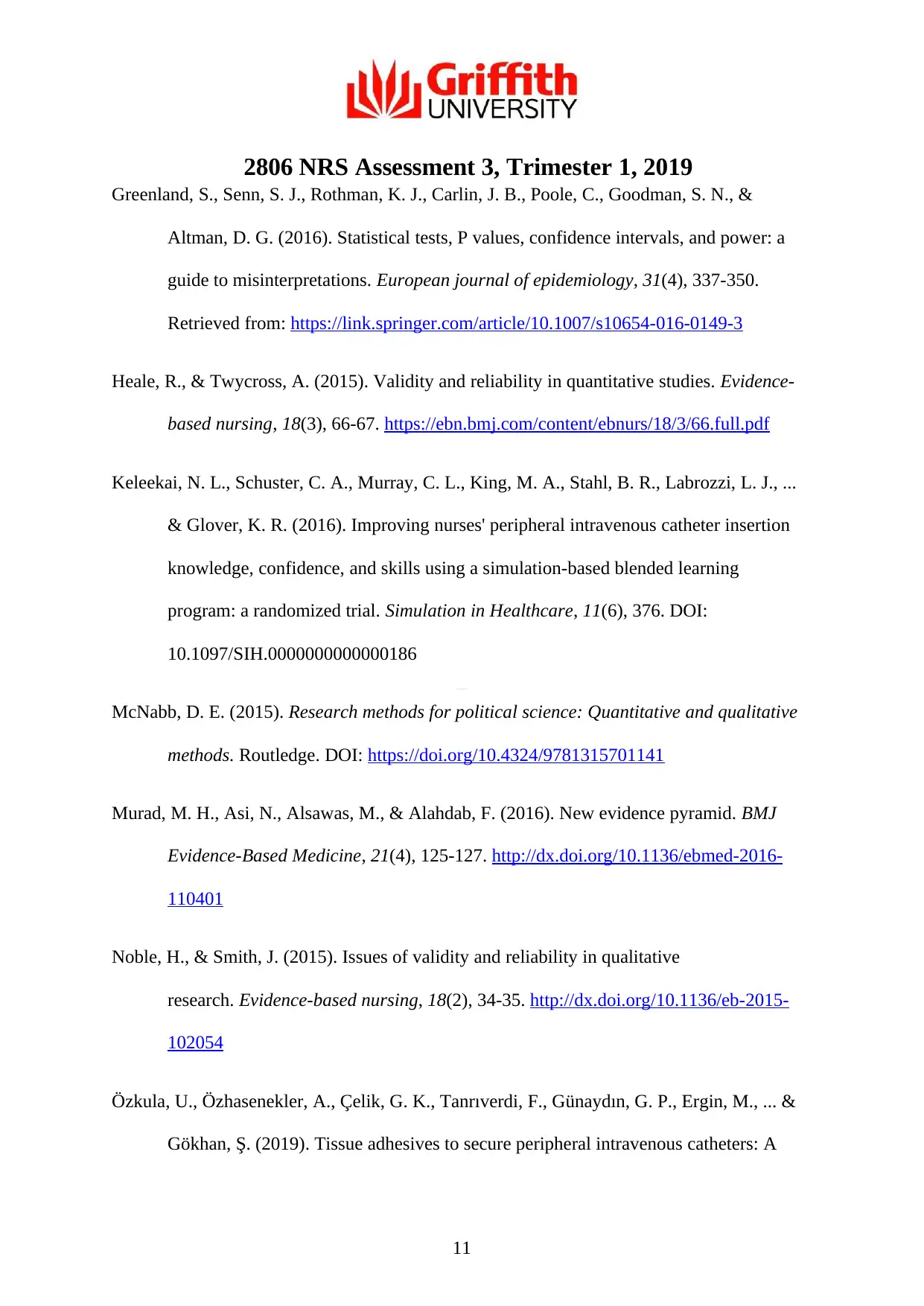
SONM Use Only
2806 NRS Assessment 3, Trimester 1, 2019
Greenland, S., Senn, S. J., Rothman, K. J., Carlin, J. B., Poole, C., Goodman, S. N., &
Altman, D. G. (2016). Statistical tests, P values, confidence intervals, and power: a
guide to misinterpretations. European journal of epidemiology, 31(4), 337-350.
Retrieved from: https://link.springer.com/article/10.1007/s10654-016-0149-3
Heale, R., & Twycross, A. (2015). Validity and reliability in quantitative studies. Evidence-
based nursing, 18(3), 66-67. https://ebn.bmj.com/content/ebnurs/18/3/66.full.pdf
Keleekai, N. L., Schuster, C. A., Murray, C. L., King, M. A., Stahl, B. R., Labrozzi, L. J., ...
& Glover, K. R. (2016). Improving nurses' peripheral intravenous catheter insertion
knowledge, confidence, and skills using a simulation-based blended learning
program: a randomized trial. Simulation in Healthcare, 11(6), 376. DOI:
10.1097/SIH.0000000000000186
McNabb, D. E. (2015). Research methods for political science: Quantitative and qualitative
methods. Routledge. DOI: https://doi.org/10.4324/9781315701141
Murad, M. H., Asi, N., Alsawas, M., & Alahdab, F. (2016). New evidence pyramid. BMJ
Evidence-Based Medicine, 21(4), 125-127. http://dx.doi.org/10.1136/ebmed-2016-
110401
Noble, H., & Smith, J. (2015). Issues of validity and reliability in qualitative
research. Evidence-based nursing, 18(2), 34-35. http://dx.doi.org/10.1136/eb-2015-
102054
Özkula, U., Özhasenekler, A., Çelik, G. K., Tanrıverdi, F., Günaydın, G. P., Ergin, M., ... &
Gökhan, Ş. (2019). Tissue adhesives to secure peripheral intravenous catheters: A
11
2806 NRS Assessment 3, Trimester 1, 2019
Greenland, S., Senn, S. J., Rothman, K. J., Carlin, J. B., Poole, C., Goodman, S. N., &
Altman, D. G. (2016). Statistical tests, P values, confidence intervals, and power: a
guide to misinterpretations. European journal of epidemiology, 31(4), 337-350.
Retrieved from: https://link.springer.com/article/10.1007/s10654-016-0149-3
Heale, R., & Twycross, A. (2015). Validity and reliability in quantitative studies. Evidence-
based nursing, 18(3), 66-67. https://ebn.bmj.com/content/ebnurs/18/3/66.full.pdf
Keleekai, N. L., Schuster, C. A., Murray, C. L., King, M. A., Stahl, B. R., Labrozzi, L. J., ...
& Glover, K. R. (2016). Improving nurses' peripheral intravenous catheter insertion
knowledge, confidence, and skills using a simulation-based blended learning
program: a randomized trial. Simulation in Healthcare, 11(6), 376. DOI:
10.1097/SIH.0000000000000186
McNabb, D. E. (2015). Research methods for political science: Quantitative and qualitative
methods. Routledge. DOI: https://doi.org/10.4324/9781315701141
Murad, M. H., Asi, N., Alsawas, M., & Alahdab, F. (2016). New evidence pyramid. BMJ
Evidence-Based Medicine, 21(4), 125-127. http://dx.doi.org/10.1136/ebmed-2016-
110401
Noble, H., & Smith, J. (2015). Issues of validity and reliability in qualitative
research. Evidence-based nursing, 18(2), 34-35. http://dx.doi.org/10.1136/eb-2015-
102054
Özkula, U., Özhasenekler, A., Çelik, G. K., Tanrıverdi, F., Günaydın, G. P., Ergin, M., ... &
Gökhan, Ş. (2019). Tissue adhesives to secure peripheral intravenous catheters: A
11
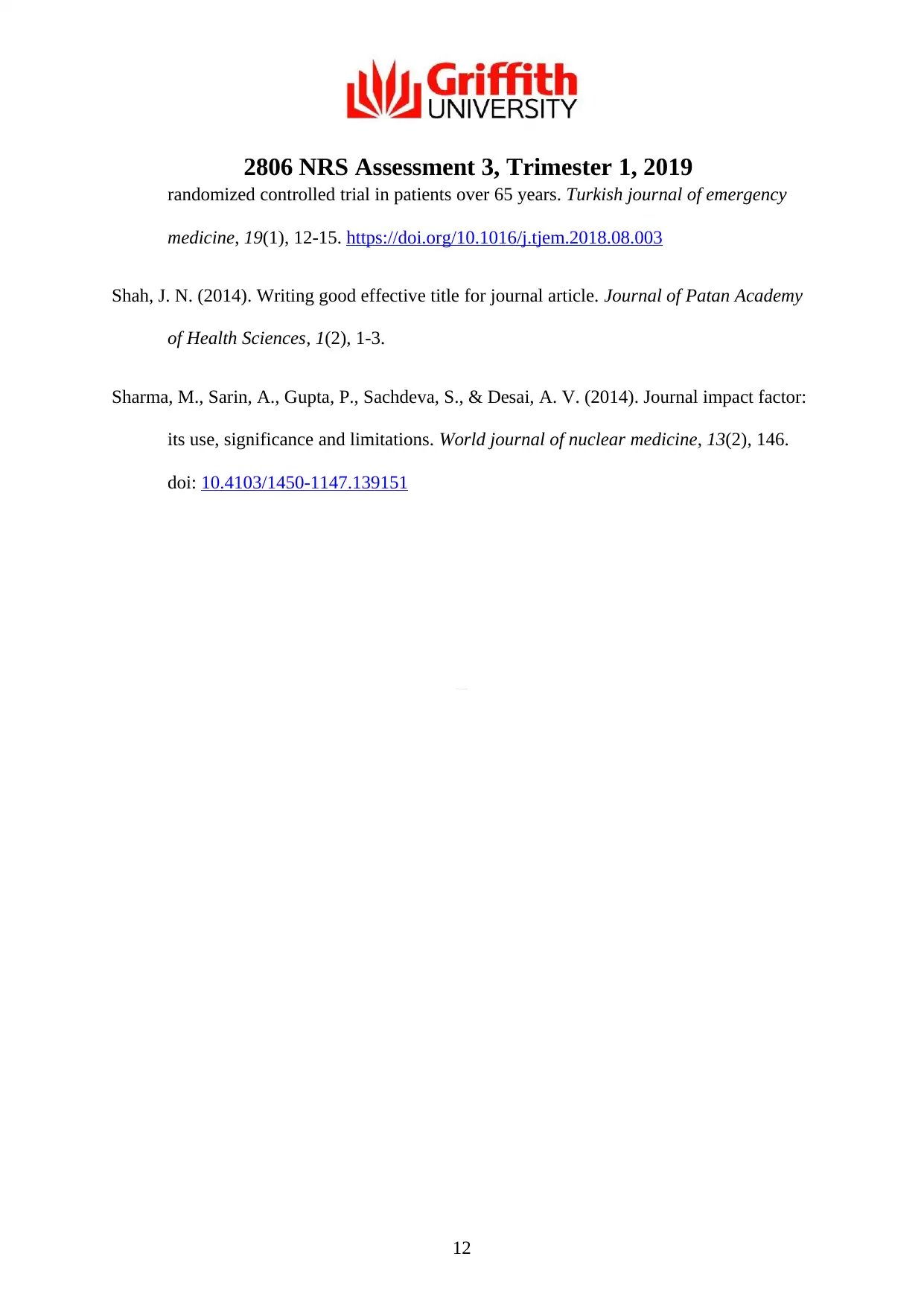
SONM Use Only
2806 NRS Assessment 3, Trimester 1, 2019
randomized controlled trial in patients over 65 years. Turkish journal of emergency
medicine, 19(1), 12-15. https://doi.org/10.1016/j.tjem.2018.08.003
Shah, J. N. (2014). Writing good effective title for journal article. Journal of Patan Academy
of Health Sciences, 1(2), 1-3.
Sharma, M., Sarin, A., Gupta, P., Sachdeva, S., & Desai, A. V. (2014). Journal impact factor:
its use, significance and limitations. World journal of nuclear medicine, 13(2), 146.
doi: 10.4103/1450-1147.139151
12
2806 NRS Assessment 3, Trimester 1, 2019
randomized controlled trial in patients over 65 years. Turkish journal of emergency
medicine, 19(1), 12-15. https://doi.org/10.1016/j.tjem.2018.08.003
Shah, J. N. (2014). Writing good effective title for journal article. Journal of Patan Academy
of Health Sciences, 1(2), 1-3.
Sharma, M., Sarin, A., Gupta, P., Sachdeva, S., & Desai, A. V. (2014). Journal impact factor:
its use, significance and limitations. World journal of nuclear medicine, 13(2), 146.
doi: 10.4103/1450-1147.139151
12
⊘ This is a preview!⊘
Do you want full access?
Subscribe today to unlock all pages.

Trusted by 1+ million students worldwide
1 out of 12
Related Documents
Your All-in-One AI-Powered Toolkit for Academic Success.
+13062052269
info@desklib.com
Available 24*7 on WhatsApp / Email
![[object Object]](/_next/static/media/star-bottom.7253800d.svg)
Unlock your academic potential
Copyright © 2020–2025 A2Z Services. All Rights Reserved. Developed and managed by ZUCOL.





